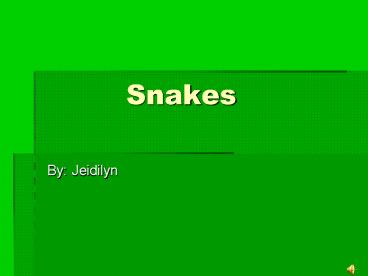Snakes - PowerPoint PPT Presentation
1 / 10
Title: Snakes
1
Snakes
- By Jeidilyn
2
Snake Habitat
- Snakes can live in Asian, South America, North
America, Europe, Africa and Australia. The
snakes live in forests mostly and live under
rocks, the rivers, water, grasslands, caves and
holes. Some desert snakes live under the sand.
They are also found in prairies.
3
How do they eat?
- Catching and eating food is a very specialised
activity. Snakes dont have claws with which to
grab, tear or hold their food, and they are
unable to chew because their teeth and hinged
jaws aren't designed for the purpose to chew
their food. Snakes are able to dislocate its
upper and lower jaw and separate the two sections
of its lower jaw. This allows it to move each jaw
by itself, and spread open its head and throat
to swallow the prey much larger than the usual
diameter of its mouth. Digestion takes place in
the stomach, with the aid of very strong
digestive juices. Unlike endothermic animals, a
snake's food digestion rate is influenced by
external temperatures .
4
What do they eat?
- It depends on what kind of snake it is, and
Snakes eat insects like termites, mice, rats,
frogs, fish, and even other snakes and reptiles
Some snakes eat eggs, swallowing the egg whole,
crushing it with its powerful muscles, and later
regurgitating the eggshell. Larger snakes, such
as the anaconda which drops on its prey from the
branches of a tree, will eat monkeys, pigs,
goats, and even deer. Snakes eat their prey whole
and are able to consume prey three times larger
than the diameter of their head because their
lower jaw can separate from the upper jaw. To
keep prey from escaping, snakes have rear-facing
teeth that hold their prey in their mouths.
Venomous snakes inject their prey with venom,
while constrictors squeeze their prey. They do
not need to hunt everyday. Anacondas and pythons
can survive for up to a year without food after
feeding. Snakes hunt mostly at night.
5
Food Web
6
What is their niche?
- Many snake species eat rats and mice, which are
pests to humans. This includes venomous species
which eat large numbers of rodents. Other snake
species eat insect pests. So this means that
snakes are predators to rodents and most snakes
are carnivores. A snakes success is their
ability to change their diet in different
seasons, eating whatever they can find.
7
Diagram of a Snake
- This picture shows the parts of the snake. In
the picture it shows the guts like the kidney,
part of the heart, and the snakes lungs. The
picture enlarged the scales and shows the parts
of the skeleton of the snake. The snakes jaw
are sharp and long.
8
Who are their predators/enemies?
- Snakes have many different types of
predators. One of their predators are the same
species as them snakes. Snakes can also be prey
to other kinds of species. - Even humans can be a predator to the snake.
They can attack their predators by biting. But
other types of snakes can bite and give poison.
9
Interesting facts about snakes
- Snakes arent slimy, their skin is very dry and
peels off. - Snakes can eat their own kind of species.
- Snakes can eat big prey like deer.
- They dont have ant eyelids.
- You may think they dont have any bones but they
do.
10
TheEnd































![[PDF] So Many Snakes, So Little Time: Uncovering the Secret Lives of Australia’s Serpents Android PowerPoint PPT Presentation](https://s3.amazonaws.com/images.powershow.com/10100064.th0.jpg?_=20240816047)